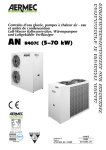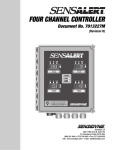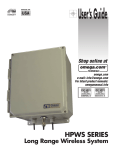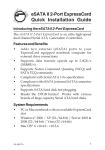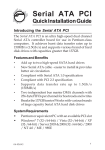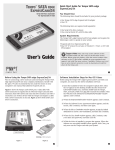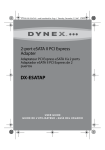Download SIIG eSATA II ExpressCard Installation guide
Transcript
eSATA II ExpressCard Quick Installation Guide Introducing the eSATA II ExpressCard The eSATA II ExpressCard is an ultra high-speed dual channel Serial ATA Generation 2 controller. Features and Benefits • • • • • • • Adds two eSATA (external Serial ATA) ports to your ExpressCard equipped notebook or desktop computer for external drive connections Supports data transfer speeds up to 3 Gb/s (300 MB/s) Compliant with Serial ATA 1.0a specification with support for full complement of SATA II optional features Supports Native Command Queuing (NCQ), Nonzero offsets NCQ, and Out-of-order data delivery NCQ Independent command fetch, scatter/gather, and command execution Supports SATA hard disk hot-plugging Breaks the 137 GB barrrier! Supports various brands of large capacity Serial ATA hard disk drives System Requirements • • ExpressCard-enabled system with an available ExpressCard/54 slot Windows® 7 (32-/64-bit) / Vista (32-/64-bit) / XP (32-/64-bit) / Server 2003 & 2008 (32-/64-bit) / 2000 04-0417C 1 Package Contents • • • eSATA II ExpressCard Driver CD Quick installation guide Layout eSATA Connectors Figure 1: eSATA II ExpressCard Hardware Installation General instructions for installing the card are provided below. Since the design of systems may vary, refer to your system’s reference manual for further information, if needed. Insert the eSATA II ExpressCard into the ExpressCard slot of your system. Make sure it is inserted all the way in for a solid connection. When connecting/disconnecting devices, holdthe eSATA II ExpressCard so it does not move from side to side, otherwise it may eject from the slot or lose connection with the operating system. 2 Driver Installation Windows 7 (32-/64-bit) 1. 2. 3. 4. 5. 6. 7. Install the ExpressCard into an ExpressCard slot. Insert the driver CD. (Close the AutoPlay box if prompted) Right click Computer, click Manage, then click Device Manager. Right click Mass Storage Controller, click Update Driver Software. Click Browse my computer for driver software. Type D:\, click Next. (Change D: to match your CD/DVD-ROM drive letter) Click Close to complete the installation. Windows Vista (32-/64-bit) 1. 2. 3. 4. Install the ExpressCard into an ExpressCard slot. At Found New Hardware, click Locate and install driver software (Recommended), then click Continue. Insert the driver CD and the driver will install automatically. Click Close to complete the installation. Windows XP (32-/64-bit) / Server 2003 (32-/64-bit) 1. 2. 3. 4. Install the ExpressCard into an ExpressCard slot. At the Found New Hardware Wizard, select No, not this time, then click Next. Skip this step if not prompted. Insert the driver CD, select Install the software automatically (Recommended), then click Next. Click Finish to complete the installation. 3 Windows Server 2008 (32-/64-bit) 1. 2. 3. 4. Install the ExpressCard into an ExpressCard slot. At the Found New Hardware window, select Locate and install driver software (Recommended), then click Don't Search Online. When prompted, insert the driver CD and Windows will automatically install the correct driver. Click Close to complete the installation. Windows 2000 1. 2. 3. 4. 5. Install the ExpressCard into an ExpressCard slot. At the Found New Hardware Wizard, click Next. Select Search for a suitable driver for my device (recommended), and click Next. Insert the driver CD, check CD-ROM drives, uncheck the other boxes, and click Next. Click Next again to continue. Click Finish to complete the installation. To Verify Windows Installation 1. 2. 4 Use Device Manager to verify installation. For Windows 7 / XP / Server 2003 / 2000: Right click Computer or My Computer, click Manage, click Device Manager. For Windows Vista: Right click Computer, click Manage, click Continue. Click Device Manager. For Windows Server 2008: Right click Computer, click Manage. Double click Diagnostics, click Device Manager. Double click either Storage controllers or SCSI and RAID controllers. Silicon Image SiI 3132 ... Controller should be displayed. External Device Connection External Serial ATA devices should come with their own accessories. In most cases, you just need to power up the external device and connect it to the external port. For more information, please refer to the external device's manual. Connecting Hard Disk Drives When connecting a hard disk drive, hold the eSATA II ExpressCard so it does not move from side to side, otherwise, it may eject from the slot. Safely Remove External Hard Disk Drives To unplug a hard disk drive from a powered up system, do the following. Windows 7 1. 2. 3. 4. 5. Right click Computer, click Manage. Select Device Manager. Double click Disk Drives, right click the target disk. Click Uninstall. Click OK to confirm device removal. You can now unplug or turn off the hard disk. Windows Vista 1. 2. 3. 4. 5. Right click Computer, click Manage, click Continue. Select Device Manager. Double click Disk Drives, right click the target disk. Click Uninstall. Click OK to confirm device removal. You can now unplug or turn off the hard disk. 5 Windows XP / Server 2003 / 2000 1. 2. 3. 4. 5. Right click My Computer and click Manage. Select Device Manager. Double click Disk Drives, right click the target disk. Click Uninstall. Click OK to confirm device removal You can now unplug or turn off the hard disk. Windows Server 2008 1. 2. 3. 4. 5. Right click Computer and click Manage. Double click Diagnostics, select Device Manager. Double click Disk Drives, right click the target disk. Click Uninstall. Click OK to confirm device removal. You can now unplug or turn off the hard disk. Removing the eSATA II ExpressCard Use Windows Safely Remove Hardware utility to stop the eSATA II ExpressCard before removing it from the ExpressCard slot. Not doing so may corrupt or destroy your data. Windows 7 1. 2. 3. 4. 6 The utility is located in the taskbar by the system clock. Click the Safely Remove Hardware and Eject Media icon. Click either Eject Mass Storage Controller or Eject ... SCSI Disk Device. At the Safe To Remove Hardware box, it is safe to remove the eSATA II ExpressCard from the ExpressCard slot. Windows Vista / Server 2008 The eSATA II ExpressCard will appear in the Safely Remove Hardware utility only if it is plugged into the computer before booting up Windows. 1. 2. 3. 4. The utility is located in the taskbar by the system clock. Click the Safely Remove Hardware icon. Click Safely remove Silicon Image SiI 3132 SATALink Controller. At the Safe To Remove Hardware box, click OK. It is now safe to remove the eSATA II ExpressCard. Note: If the eSATA II ExpressCard does not appear in the Safely Remove Hardware utility, the connected hard disk drive(s) must first be stopped before removing it from the ExpressCard slot. Not stopping the hard drives prior to removal may corrupt or destroy any data on the hard disk drive. See Safely Remove External Hard Disk Drives on page 5 for more information. Windows XP / Server 2003 / 2000 1. 2. 3. The utility is located in the taskbar by the system clock. For Windows XP / Server 2003 & 2008: Click the Safely Remove Hardware icon. For Windows 2000: Click the Unplug or Eject Hardware icon. Click Safely remove Silicon Image SiI 3132 SATALink Controller. Wait for the Safe to Remove Hardware pop-up box to appear before removing the eSATA II ExpressCard from the ExpressCard slot. 7 Assigning Drive Letter to an External Hard Disk Most external hard disks come formatted and ready to use. When connected, a drive icon will show up in Computer/My Computer and you can access the drive. However, sometimes Windows will not automatically assign a drive letter to a formatted external hard disk drive, in this case, the drive icon will not show up in Computer/My Computer. If this happens, follow the directions below to assign a drive letter to the hard disk. You will only need to do this the very first time a hard disk is connected. These steps, taken from Windows Server 2003, are similar for all Windows versions. 1. Right click Computer or My Computer, click Manage, click Disk Management. Look for a Healthy disk without a name and drive letter assigned to it, see the shaded area in Figure 2. Figure 2: Windows Disk Management 8 2. Right click on the Healthy disk (the disk without a name and drive letter), then click Change Drive Letter and Paths. See Figure 3. Figure 3 3. At Change Drive Letters and Paths, click Add. Figure 4 9 4. At Add Drive Letter or Path, select Assign the following drive letter, then choose any available drive letter from the drop down box. Click OK. Figure 5 5. A drive letter, in this example G:, should be assigned to the Healthy drive. Repeat these steps if no drive letter appears. Figure 6 10 Technical Support and Warranty QUESTIONS? SIIG’s Online Support has answers! Simply visit our web site at www.siig.com and click Support. Our online support database is updated daily with new drivers and solutions. Answers to your questions could be just a few clicks away. You can also submit questions online and a technical support analysts will promptly respond. SIIG offers a lifetime manufacturer warranty with this product. Please see our web site for more warranty details. If you encounter any problems with this product, please follow the procedures below. A) If it is within the store's return policy period, please return the product to the store where you purchased from. B) If your purchase has passed the store's return policy period, please follow these steps to have the product repaired or replaced. Step 1: Submit your RMA request. Go to www.siig.com, click Support, then RMA to submit a request to SIIG RMA. Your RMA request will be processed, if the product is determined to be defective, an RMA number will be issued. Step 2: After obtaining an RMA number, ship the product. • Properly pack the product for shipping. All software, cable(s) • and any other accessories that came with the original package must be included. Clearly write your RMA number on the top of the returned package. SIIG will refuse to accept any shipping package, and will not be responsible for a product returned without an RMA number posted on the outside of the shipping carton. • You are responsible for the cost of shipping. Ship the product to the following address: SIIG, Inc. 6078 Stewart Avenue Fremont, CA 94538-3152, USA RMA #: • SIIG will ship the repaired or replaced product via Ground in the U.S. and International Economy outside of the U.S. at no cost to the customer. 11 About SIIG, Inc. Founded in 1985, SIIG, Inc. is a leading manufacturer of IT connectivity solutions (including Serial ATA and Ultra ATA Controllers, FireWire, USB, and legacy I/O adapters) that bridge the connection between Desktop/ Notebook systems and external peripherals. SIIG continues to grow by adding A/V and Digital Signage connectivity solutions to our extensive portfolio. All centered around the distribution and switching of A/V signals over CAT5/6, these products include matrix switches, distribution amplifiers, extenders, converters, splitters, cabling, and more. SIIG is the premier one-stop source of upgrades and is committed to providing high quality products while keeping economical and competitive prices. High-quality control standards are evident by one of the lowest defective return rates in the industry. Our products offer comprehensive user manuals, user-friendly features, and most products are backed by a lifetime warranty. SIIG products can be found in many computer retail stores, mail order catalogs, and e-commerce sites in the Americas, as well as through major distributors, system integrators, and VARs. PRODUCT NAME eSATA II ExpressCard FCC RULES: TESTED TO COMPLY WITH FCC PART 15, CLASS B OPERATING ENVIRONMENT: FOR HOME OR OFFICE USE FCC COMPLIANCE STATEMENT: This device complies with part 15 of the FCC Rules. Operation is subject to the following two conditions: (1) This device may not cause harmful interference, and (2) this device must accept any interference received, including interference that may cause undesired operation. THE PARTY RESPONSIBLE FOR PRODUCT COMPLIANCE SIIG, Inc. 6078 Stewart Ave. Fremont, CA 94538-3152, USA Phone: 510-657-8688 eSATA II ExpressCard is a trademark of SIIG, Inc. SIIG and the SIIG logo are registered trademarks of SIIG, Inc. Microsoft and Windows are registered trademarks of Microsoft Corporation. All other names used in this publication are for identification only and may be trademarks of their respective owners. April, 2010 Copyright © 2010 by SIIG, Inc. All rights reserved.












